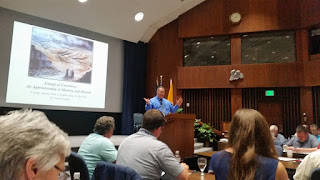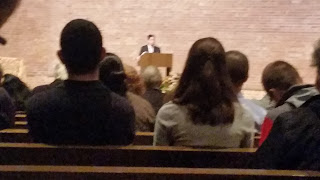Personally, I am tired and rather discouraged that the battle for decency, justice, human solidarity and peace seems so much more difficult these days. For now, at least, it looks like many of humankind's baser instincts have been unleashed upon our nation - from all sides of the political divide.
That's why I read that marvelous Collect in the Roman Missal for the First Sunday in Advent differently this year:
Grant your faithful, we pray, almighty God,Resolve. For me, that is a strong "ask" this year. Negativity cannot be allowed to triumph. Injustice, hatred, prejudice and anger cannot be allowed to triumph. Most of all, fear cannot be allowed to triumph.
the resolve to run forth to meet your Christ
with righteous deeds at his coming,
so that, gathered at his right hand,
they may be worthy to possess the heavenly Kingdom.
Through our Lord Jesus Christ, your Son,
who lives and reigns with you in the unity of the Holy Spirit,
one God, for ever and ever.
I want to run forth to meet Jesus, but my heart is too heavy for that sort of eagerness right now. Lord, grant my heart wings and give the strength to stand upright in your light.
What are the righteous deeds God asks? The core message of the Gospel certainly calls us to love our neighbor. But today, who is our neighbor? For me, my literal neighbors are the Mexican-American family across the hall, the white-like-me single mom and her teenage son next door, the Muslim family down the hall, the East Indian and Eastern European families upstairs, the maintenance guys who only speak Spanish... Yes, these are all my neighbors. Broader than that, however, my neighbors are my "friends" online - people of all races and orientations - on all sides of that very contentious political spectrum.
What righteous deeds will make me worthy to possess the Kingdom? Jesus has defined them in Matthew 25 and the Tradition of the Church has interpreted these as the Works of Corporal Mercy:
To feed the hungry.This year, this list seems to present an even bigger challenge. It seems to me that if we profess to follow Christ, we should not only perform these acts on a personal level, but also stand firmly against those who, out of self-interest, desire for financial gain, and prejudice wish to abandon the very people who most need our help. Should we not speak up when the disabled are mocked, when the elderly are threatened with loss of the "entitlements" for which they have worked their entire lives, when refugees are refused asylum, when women are insulted and assaulted because of their gender, and when all immigrants come under suspicion? Should we not speak up when the rich are rewarded for being rich and the poor are penalized for being poor? And should we not speak up against these forms of injustice just as loudly as we have spoken up.in the name of God for the rights of the unborn? As the song says, if I don't do that, what good am I?
To give drink to the thirsty.
To clothe the naked.
To welcome the stranger.
To visit the sick.
To visit the imprisoned.
To bury the dead.
This is not mere politics. This is a fight for Christian principles against a climate of self-interest and self-righteousness. This is resistance against a culture in which many no longer see justice for all as necessary, because some are more valuable than others. It is a fight to preserve the rights to life, liberty and the pursuit of happiness for all, not just for some.
I want to be able to present Christ with righteous deeds, but today, the responsibility seems particularly heavy. Lord, lift me up and strengthen me to serve and advocate for the "other" - those who are unfortunate, different and rejected.
As I light the first candle on my home Advent wreath tonight, I will most ask for hope. Hope that I might be a light in the darkness. Hope that I will not lose heart. Hope that other people of good will will likewise work while the night is upon us so that when the dawn of the Son of Justice arrives, we will be able to say we fought the good fight in his name.
Come, Lord Jesus!



























